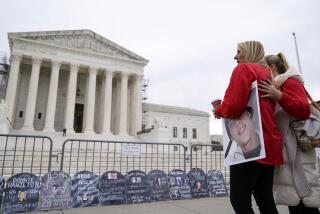Editorial: Why is Guantanamo Bay prison still open?

Protestors wear orange detainee jumpsuits and black hoods as they hold a banner calling for the closing of the US detention center at Guantanamo naval base in Cuba in front of the White House in Washington on January 11, 2014.
One of President Obama’s first acts in office was to promise that he would close the military prison at Guantanamo Bay in order to “restore the standards of due process and the core constitutional values that have made this country great even in the midst of war, even in dealing with terrorism.” Six years later, the facility is still open, although the population has dwindled to 116, 52 of whom have been cleared for transfer if security conditions can be satisfied.
Part of the problem has been congressional obstructionism, but Obama also is to blame. Rather than veto defense authorization bills that limited his ability to transfer inmates, he has signed them, while raising questions about whether they intruded on his constitutional authority. And he hasn’t pressed the Defense Department hard enough to approve the release and resettlement of detainees who aren’t deemed a threat.
Now the White House says it is preparing to present Congress with a new plan to close the facility. That effort is welcome, but it will fully succeed only if the administration recognizes that the problem with Guantanamo isn’t just its location, but that the prison has become a symbol of a denial of due process.
Opposition to closing Guantanamo involves two issues. One is whether even “low-risk” detainees should be released to their homelands or to some other country. The other is whether inmates — including dozens of more dangerous detainees the administration says it can neither release nor try — should be moved to the United States. The administration argues persuasively that “supermax” prisons in this country provide adequate protection for public safety.
We agree with Obama that Guantanamo has been a stain on America’s reputation and a recruiting tool for terrorists. The administration should make good on its threat to veto a new National Defense Authorization Act if it makes it harder to release detainees or to shut down the prison. But even if the administration wins congressional support for closing the facility and accelerating the release of some detainees, it shouldn’t be content with simply relocating the rest and continuing to hold them without charge or trial.
In a 2013 speech, Obama acknowledged that indefinitely detaining suspected terrorists without a trial was a problem but said it could be resolved “consistent with our commitment to the rule of law.” The way to do so is to urgently revisit the question of whether supposedly high-risk detainees really pose a danger if they are released. The government should also take a fresh look at whether it really is impossible to prosecute some detainees because of missing or compromised evidence.
In the same speech, Obama warned that “history will cast a harsh judgment on this aspect of our fight against terrorism and those of us who fail to end it.” The way to forestall such a judgment is to close Guantanamo and not reconstitute it elsewhere.
Follow the Opinion section on Twitter @latimesopinion and Facebook
More to Read
A cure for the common opinion
Get thought-provoking perspectives with our weekly newsletter.
You may occasionally receive promotional content from the Los Angeles Times.






